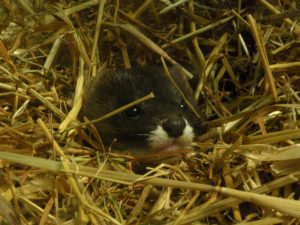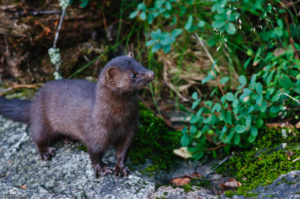The European mink (Mustela lutreola) has a long, slender body with a short tail. The weasel-like mammal is usually dark brown to black, with a thin white patch around the mouth that sometimes continues down the neck. It is this contrasting marking that distinguishes them from the similar American mink (Mustela vison).

The white markings on the upper lip distinguish the European mink from its American cousin. Photo by EfAston
As a semi-aquatic species, they have a dense, short coat with a water-repellent undercoat to insulate them in the water. Excellent swimmers, their paws are webbed to help them swim, dive, and hunt underwater.
European minks are largely nocturnal, solitary animals. They have a wide range of prey from small mammals, fish, crustaceans, insects and more. They occupy large ranges, always near fresh water. A female mink may stay near a den within her territory, while males venture much farther.

The American Mink (Neovison vison). Photo by Leo-Avalon/ Flickr CC
The European mink is one of Europe’s most endangered mammals. In 2011, the species was upgraded from Endangered (EN) to Critically Endangered (CR) on the IUCN Red List. Their range has been reduced by at least 90% since the mid-19th century. The minks suffered from overexploitation for their fur in the early 20th century, leading to a weakened population. In 1926, the larger American mink was introduced to Eastern Europe to be used for its more valuable pelts. The American mink’s presence put great pressure on food and habitat availability, pushing the European mink out of much of its range. Additionally, human expansion and increased land use, as well as hydroelectric developments and water pollution has led to a fragmented population.
Currently, the European mink population exists in isolated regions in Russia, with small introduced subpopulations in France and Spain. Most of these groups are in rapid decline and low density. There are many captive breeding programs working to establish new European mink populations and add new genetic diversity to existing groups. Efforts are being made to restore and designate protected areas and maintain standing ones.

European mink range. Colors show where minks are: extant (brown), introduced (red), and possibly extinct (orange). Image created by Chermundy using IUCN Red List distribution data.
Carnivore Connection: June 2018
/in Newsletter Archive, Publications /by Stefanie SillerCarnivore Connection: March 2018
/in Newsletter Archive /by Stefanie SillerCarnivore Connection: December 2017
/in Newsletter Archive /by Stefanie SillerCarnivore Connection: February 2018
/in Newsletter Archive /by Stefanie SillerTotal time learners might complete the A.
/in Uncategorized /by Stefanie SillerS.P.E.C.I.E.S. at Safari West
/in Activities & Events /by Stefanie SillerOn March 3, S.P.E.C.I.E.S. founder and director Dr. Anthony Giordano was honored to present “Clouded in Mystery: Introducing the enigmatic clouded leopard” at Safari West’s Conservation Dinner Series. His talk focused on S.P.E.C.I.E.S.’s Project Neofelis, which works to conserve the vulnerable clouded leopard and promote it as a flagship species.
Safari West is dedicated to actively promoting conservation and environmental education, while sharing knowledge that empowers individuals to think sustainably about their role in the environment and the world at large.
World Wildlife Day at the U.N.
/in Activities & Events /by Stefanie SillerThis World Wildlife Day, S.P.E.C.I.E.S. staff joined the CITES Secretariat at the United Nations in New York City to discuss the theme “Big cats: predators under threat”. S.P.E.C.I.E.S. staff were privileged to hear from panels of speakers that included organizations such as Panthera and the World Wildlife Fund (WWF), and representatives of nations including Panama, the Kyrgyz Republic, and Thailand. Discussions ranged from snow leopard conservation, regional jaguar project collaboration, and tiger success stories, as well as the expansion of community based conservation.
The event ended with an announcement of the winners of the Jackson Hole WILD Film Festival.
Miss it? You can watch the UN proceedings here
S.P.E.C.I.E.S. presents at UCLA Institute of the Environment and Sustainability
/in Activities & Events /by Stefanie SillerThe Founder, Director, and Chief Conservation Officer of S.P.E.C.I.E.S., Dr. Anthony Giordano, spoke at the UCLA Institute of the Environment and Sustainability as a Senior Research Fellow of the Center for Tropical Research. Dr. Giordano’s dedication to ecological preservation drove him to establish S.P.E.C.I.E.S., which promotes carnivores as umbrella species, aids in the mitigation of human-wildlife conflict, and supports international capacity building.
For more on Dr. Giordano and his contributions to wildlife conservation, follow the link below:
The European Mink
/in In The Spotlight, Meet The Carnivores /by Stefanie SillerThe European mink (Mustela lutreola) has a long, slender body with a short tail. The weasel-like mammal is usually dark brown to black, with a thin white patch around the mouth that sometimes continues down the neck. It is this contrasting marking that distinguishes them from the similar American mink (Mustela vison).
The white markings on the upper lip distinguish the European mink from its American cousin. Photo by EfAston
As a semi-aquatic species, they have a dense, short coat with a water-repellent undercoat to insulate them in the water. Excellent swimmers, their paws are webbed to help them swim, dive, and hunt underwater.
European minks are largely nocturnal, solitary animals. They have a wide range of prey from small mammals, fish, crustaceans, insects and more. They occupy large ranges, always near fresh water. A female mink may stay near a den within her territory, while males venture much farther.
The American Mink (Neovison vison). Photo by Leo-Avalon/ Flickr CC
The European mink is one of Europe’s most endangered mammals. In 2011, the species was upgraded from Endangered (EN) to Critically Endangered (CR) on the IUCN Red List. Their range has been reduced by at least 90% since the mid-19th century. The minks suffered from overexploitation for their fur in the early 20th century, leading to a weakened population. In 1926, the larger American mink was introduced to Eastern Europe to be used for its more valuable pelts. The American mink’s presence put great pressure on food and habitat availability, pushing the European mink out of much of its range. Additionally, human expansion and increased land use, as well as hydroelectric developments and water pollution has led to a fragmented population.
Currently, the European mink population exists in isolated regions in Russia, with small introduced subpopulations in France and Spain. Most of these groups are in rapid decline and low density. There are many captive breeding programs working to establish new European mink populations and add new genetic diversity to existing groups. Efforts are being made to restore and designate protected areas and maintain standing ones.
European mink range. Colors show where minks are: extant (brown), introduced (red), and possibly extinct (orange). Image created by Chermundy using IUCN Red List distribution data.
S.P.E.C.I.E.S. at ZACC
/in Activities & Events /by Stefanie SillerFrom January 22-26, S.P.E.C.I.E.S. attended the ZACC Conference in Jacksonville, Florida. ZACC, Zoos & Aquariums Committing to Conservation, brings together zoo and aquarium professionals from all departments as well as field conservationists from around the world for a 5-day event. S.P.E.C.I.E.S. held a table and presented a poster on two of our key projects, the Chaco Jaguar Conservation Project, and Project Neofelis. We also got the chance to meet and connect with inspiring individuals from across the zoo and field conservation world.
The conference concluded with a day at the Jacksonville Zoo, where S.P.E.C.I.E.S. team members got the chance to come up close with some of our favorite carnivores!
Behind the scenes at the Jacksonville Zoo to learn how zookeepers care for the endangered Florida panther
To learn more about this year’s ZACC, check out https://zaccjax.weebly.com/